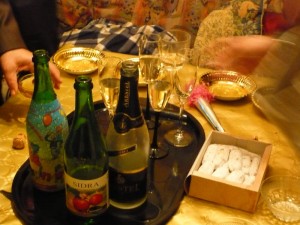New Years in Spain
 The Spaniards are best known for their festive parties and hedonistic indulgence. New Year celebrations are no exceptions – expect phenomenal feasting, plenty of dressing up, drinking and partying till dawn.
The Spaniards are best known for their festive parties and hedonistic indulgence. New Year celebrations are no exceptions – expect phenomenal feasting, plenty of dressing up, drinking and partying till dawn.
From Christmas Day till the Three Kings’ Day (Dia de Los Reyes Magos) on 6th January, the celebrations almost don’t stop. Streets are lined with shops, lights and festive mood, while supermarkets rack up the prices of essential New Years foods.
If you are travelling to Spain during this holiday season, be sure to search for your flights to Spain in advance (prices get way high!) and prepare for some overloading of Spanish food and drinks! To prepare you for the epic New Year’s celebration, here are some things you should know about New Years in Spain before you go.
New Year’s Traditions in Spain
- New Year’s Eve is also known as Nochevieja or Fin de Año in Spanish. Like Christmas, celebrations usually begin with a family dinner, traditionally a major seafood feast that includes shrimps, fish, calamares and lamb, topped with an endless flow of Spanish champagne, cava.
- Spanish tradition says that wearing new, red underwear on New Year’s Eve brings good luck. The Spaniards usually celebrate New Year’s Eve with their families, and everyone is dressed formally from head to toe.
- The actual countdown is usually held at home, as the family gathers around the television to count down along to the clock on top of the Casa de Correos building in Puerta del Sol square in Madrid. During the countdown, the Spaniards have a quirky tradition of swallowing twelve grapes, one at each chime of the clock. This tradition has its origins in 1909, when grape growers in Alicante thought of it as a way to cut down on the large production surplus they had had that year. Nowadays, the tradition is followed by almost every Spaniard, and the twelve grapes have become synonymous with the New Year. After the clock has finished striking twelve, people greet each other and toast to the arrival of new year with champagne and cider.
- After the family dinner and the grapes, most young adults attend New Year parties at pubs and discos (these parties are called cotillones de nochevieja, after the Spanish word cotillón, which refers to party supplies like confetti, party blowers, party hats, etc.). Parties usually last until the next morning and range from small, personal celebrations at local bars to huge parties with guests numbering the thousands at hotel convention rooms. Early next morning, party attendees usually gather to have the traditional winter breakfast of chocolate con churros (hot chocolate and fried pastry).
New Years in Spain might be quite pricey depending on your plans – prices at the hottest party spots are likely to rise and entrance fees for the cotillones de nochevieja can cost anything between 50 to 200 euros per person. Expect Spanish hostels prices to be higher than usual in major cities on New Year’s Eve. Also, expect most restaurants to close on New Years Day – either scope out a place in advance that will be opened, or stock up on picnic items beforehand and plan to “eat in” that day.
If you’re spending the whole holiday season, read more about Christmas in Spain.